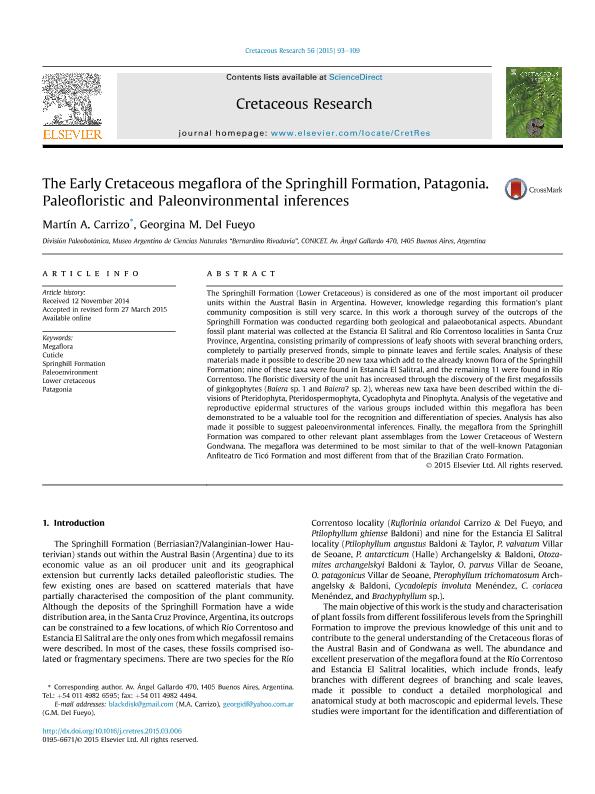Mostrar el registro sencillo del ítem
dc.contributor.author
Carrizo, Martin Alejandro

dc.contributor.author
del Fueyo, Georgina Marisa

dc.date.available
2018-05-24T21:16:50Z
dc.date.issued
2015-09
dc.identifier.citation
Carrizo, Martin Alejandro; del Fueyo, Georgina Marisa; The Early Cretaceous megaflora of the Springhill Formation, Patagonia. Paleofloristic and Paleonvironmental inferences; Academic Press Ltd - Elsevier Science Ltd; Cretaceous Research; 56; 9-2015; 93-109
dc.identifier.issn
0195-6671
dc.identifier.uri
http://hdl.handle.net/11336/46190
dc.description.abstract
The Springhill Formation (Lower Cretaceous) is considered as one of the most important oil producer units within the Austral Basin in Argentina. However, knowledge regarding this formation's plant community composition is still very scarce. In this work a thorough survey of the outcrops of the Springhill Formation was conducted regarding both geological and palaeobotanical aspects. Abundant fossil plant material was collected at the Estancia El Salitral and Río Correntoso localities in Santa Cruz Province, Argentina, consisting primarily of compressions of leafy shoots with several branching orders, completely to partially preserved fronds, simple to pinnate leaves and fertile scales. Analysis of these materials made it possible to describe 20 new taxa which add to the already known flora of the Springhill Formation; nine of these taxa were found in Estancia El Salitral, and the remaining 11 were found in Río Correntoso. The floristic diversity of the unit has increased through the discovery of the first megafossils of ginkgophytes (Baiera sp. 1 and Baiera? sp. 2), whereas new taxa have been described within the divisions of Pteridophyta, Pteridospermophyta, Cycadophyta and Pinophyta. Analysis of the vegetative and reproductive epidermal structures of the various groups included within this megaflora has been demonstrated to be a valuable tool for the recognition and differentiation of species. Analysis has also made it possible to suggest paleoenvironmental inferences. Finally, the megaflora from the Springhill Formation was compared to other relevant plant assemblages from the Lower Cretaceous of Western Gondwana. The megaflora was determined to be most similar to that of the well-known Patagonian Anfiteatro de Tico Formation and most different from that of the Brazilian Crato Formation.
dc.format
application/pdf
dc.language.iso
eng
dc.publisher
Academic Press Ltd - Elsevier Science Ltd

dc.rights
info:eu-repo/semantics/openAccess
dc.rights.uri
https://creativecommons.org/licenses/by-nc-sa/2.5/ar/
dc.subject
Cuticle
dc.subject
Springhill Formation
dc.subject
Paleoenvironment
dc.subject
Lower Cretaceous
dc.subject
Patagonia
dc.subject.classification
Meteorología y Ciencias Atmosféricas

dc.subject.classification
Ciencias de la Tierra y relacionadas con el Medio Ambiente

dc.subject.classification
CIENCIAS NATURALES Y EXACTAS

dc.title
The Early Cretaceous megaflora of the Springhill Formation, Patagonia. Paleofloristic and Paleonvironmental inferences
dc.type
info:eu-repo/semantics/article
dc.type
info:ar-repo/semantics/artículo
dc.type
info:eu-repo/semantics/publishedVersion
dc.date.updated
2018-05-23T16:33:55Z
dc.identifier.eissn
1095-998X
dc.journal.volume
56
dc.journal.pagination
93-109
dc.journal.pais
Países Bajos

dc.journal.ciudad
Amsterdam
dc.description.fil
Fil: Carrizo, Martin Alejandro. Consejo Nacional de Investigaciones Científicas y Técnicas. Oficina de Coordinación Administrativa Parque Centenario. Museo Argentino de Ciencias Naturales "Bernardino Rivadavia"; Argentina
dc.description.fil
Fil: del Fueyo, Georgina Marisa. Consejo Nacional de Investigaciones Científicas y Técnicas. Oficina de Coordinación Administrativa Parque Centenario. Museo Argentino de Ciencias Naturales "Bernardino Rivadavia"; Argentina
dc.journal.title
Cretaceous Research

dc.relation.alternativeid
info:eu-repo/semantics/altIdentifier/doi/https://doi.org/10.1016/j.cretres.2015.03.006
dc.relation.alternativeid
info:eu-repo/semantics/altIdentifier/url/https://www.sciencedirect.com/science/article/pii/S019566711500035X
Archivos asociados
